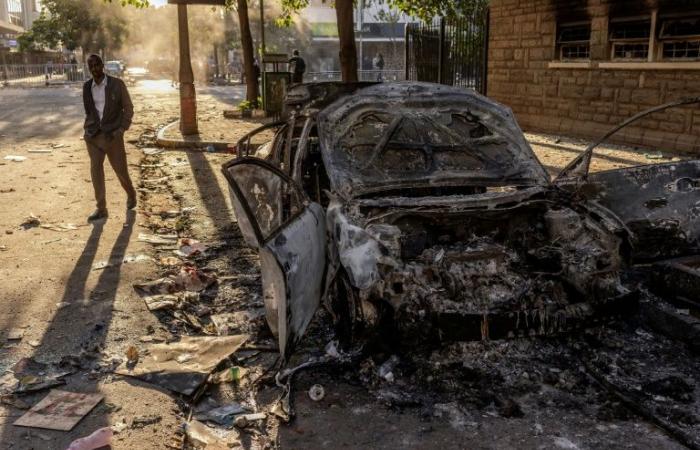Protests in Kenya: at least 13 people killed on Tuesday, according to an association of doctors
At least 13 people were killed in Kenya on Tuesday during a day of anti-government protests which turned into chaos, the president of the country’s main professional association of doctors told AFP on Wednesday, believing that this toll remained provisional.
“So far we have at least 13 people killed, but that is not the final figure. (…) We have never seen before, we have seen violence in 2007 following the elections, but never this level of violence against unarmed people,” said Kenya Medical Association president Simon Kigondu.
Kenya woke up in a state of shock on Wednesday following the violence, which notably saw demonstrators storm Parliament, a first in the history of the independent country since 1963.
“Deaths, disorder”, headlined the daily The Standard, while the Daily Nation described the situation as “Pandemonium” (capital of hell, editor’s note), estimating that “the foundations of the country have been profoundly shaken”, with several deaths and scenes of chaos in the center of the capital Nairobi.
The rallies, mainly led by young people, began peacefully last week, with thousands of demonstrators marching in Nairobi and other cities across the country to protest against new taxes planned in the 2024-2025 budget, currently being debated in parliament.
On Tuesday, while opponents demonstrated for the third time in eight days, tension suddenly rose in the afternoon in Nairobi.
According to NGOs, including the Kenyan branch of Amnesty International, the police fired live ammunition to try to contain the crowd, which forced security barriers to enter the Parliament grounds. Buildings were ransacked and partially burned.
Looting took place in Nairobi and several towns. Buildings were burned in Eldoret, in the Rift Valley, the stronghold of President William Ruto.
A few hours later, the government announced that it was deploying the army to support the police in the face of this “security emergency” and these “destructions and intrusions into crucial infrastructure”.
In the evening, President Ruto displayed his firmness by pledging to firmly repress “violence and anarchy”, promising in particular to make pay these “criminals posing as peaceful demonstrators” who are causing “a reign of terror against the people, their elected representatives and institutions.
– Looting –
The government was taken by surprise by the intensity of the opposition to its plans for tax increases, mainly led by young Kenyans from “Generation Z” (young people born after 1997).
On Wednesday morning, a strong police presence was deployed around parliament, where the scent of tear gas was still in the air, AFP noted.
Posted in front of the broken barricades of the complex, a police officer explained to AFP that he was shocked by what he saw the day before on television. “It was crazy, we hope that calm will return today,” he said.
The main opposition coalition, Azimio, led by historic opponent Railla Odinga, accused the government of having “unleashed its brute force” against the demonstrators and urged the police to “stop shooting at innocent, peaceful and unarmed.”
The group of NGOs led by Amnesty Kenya also highlighted on Tuesday having noted 21 kidnappings of people by “officers in uniform or in plain clothes” during the previous 24 hours, accusations on which the police, requested by the AFP, did not didn’t react.
– International concern –
The violence and scenes of chaos in Nairobi on Tuesday alarmed the United States and more than a dozen European countries, as well as the UN and the African Union, which declared themselves “deeply concerned” by the violence and called quiet.
The protest movement against taxes, called “Occupy Parliament”, was launched on social networks shortly after the presentation to Parliament on June 13 of the 2024-2025 draft budget providing in particular for a VAT of 16% on bread and an annual tax of 2.5% on private vehicles.
After the start of protests, the government, which considers new taxes necessary in view of the country’s heavy debt, announced on June 18 that it was withdrawing most of the measures planned for this purpose.
But the demonstrators demand the complete withdrawal of the text.
Before Tuesday, this mobilization had already been marked by the death of two people in Nairobi, as well as dozens of injuries and hundreds of arrests.
Do you have a real estate project in mind? Yakeey & Médias24 help you make it happen!






